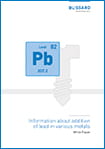The usage of lead as addition to metals and its consequences
The purpose of this white paper is to provide information on the usage of lead as addition to various metals as well as the alternatives and their consequences. Together with information about the requirements of applicable industrial standards, it is intended to display the current situation on the market.
Lead might be found as a component in materials intended for machining operations. A range of e.g. machine keys, pins and plugs are made from leaded materials to fulfil the material requirements of given standards. No other material options are available per standards currently.
In fact, the vast majority of fastener standards do not specify the exact material composition of the product. The geometrical shape of the product, the mechanical and physical properties and the selected manufacturing process of the manufacturer, determines the selected material. As most materials are produced by recycling, lead can potentially be present if it doesn’t negatively affect the product requirements given by the standards.
Where lead is not added intentionally (materials not intended for machining operations) to the material, it will most often not appear from the material certificate. The likelihood that such materials contain lead in concentrations above 0.1% by weight is low but cannot be ensured without additional investigations and/or tests.
After a short preface, the following topics are described in detail in the professional white paper by Peter Witzke, head of Bossard's team of experts:
- History of usage of lead
- Availability and recovery of lead
- Leaded steel, brass,bronze, aluminium and casting alloys
- Alternatives to lead
- Lead in fasteners and other metallic products from Bossard

Download now your full white paper for free and learn more about the usage of lead as addition to various metals as well as the alternatives and their consequences.

